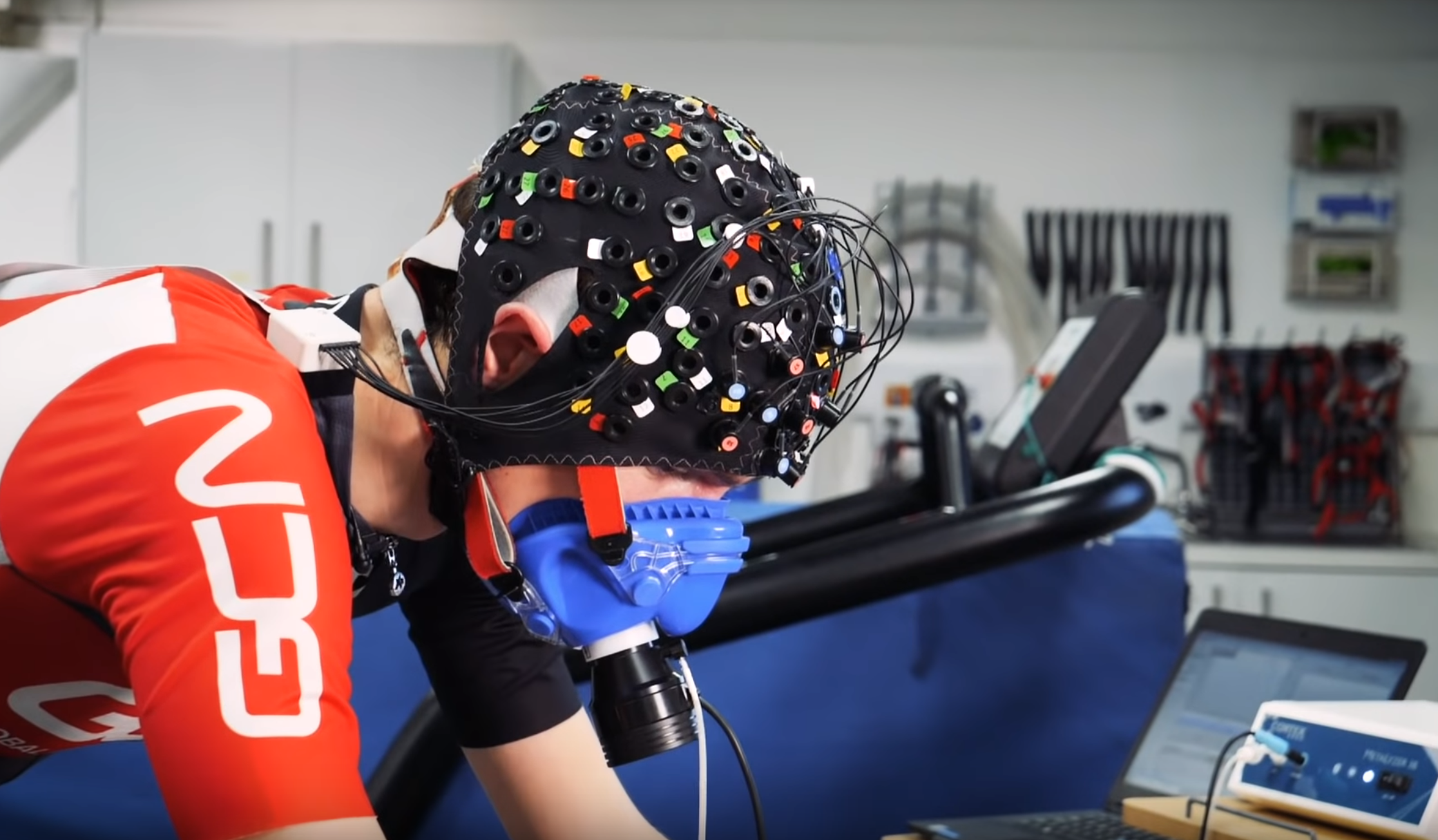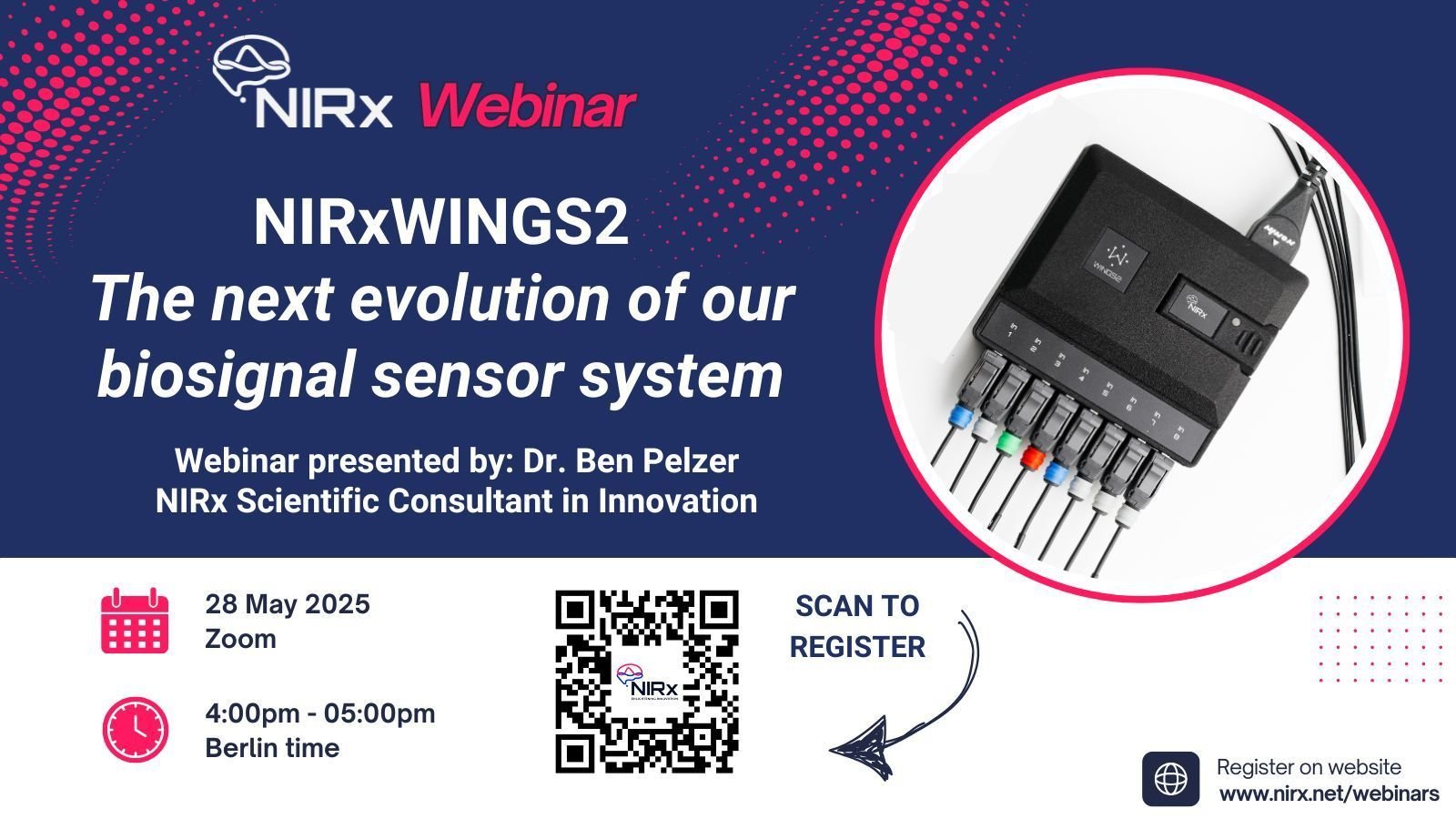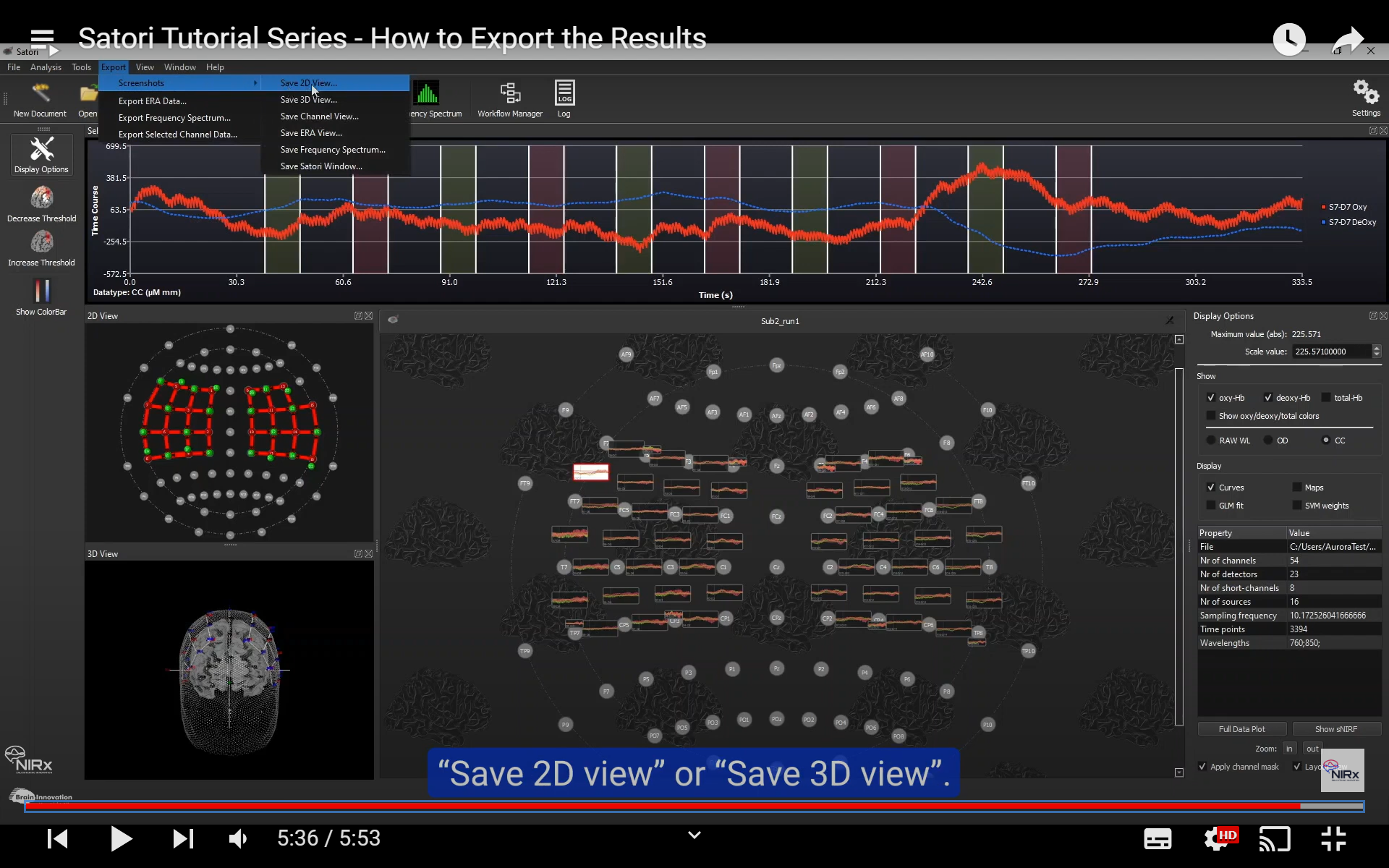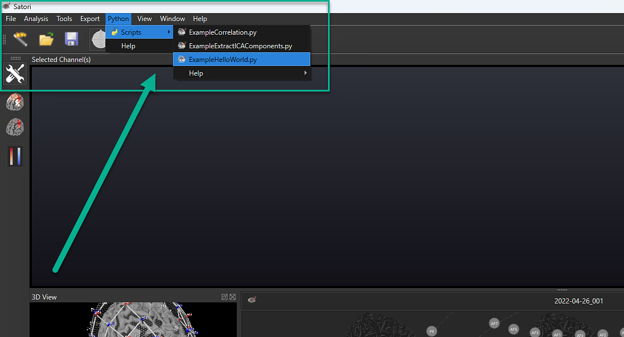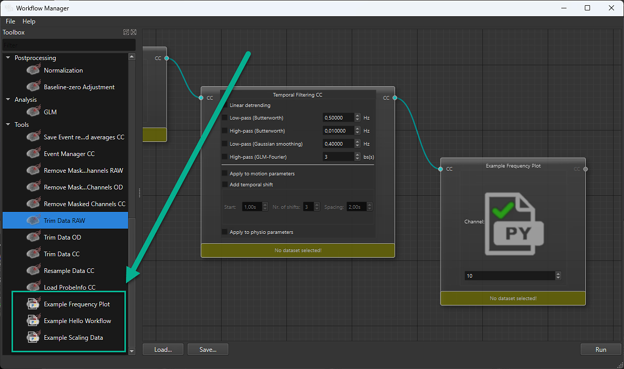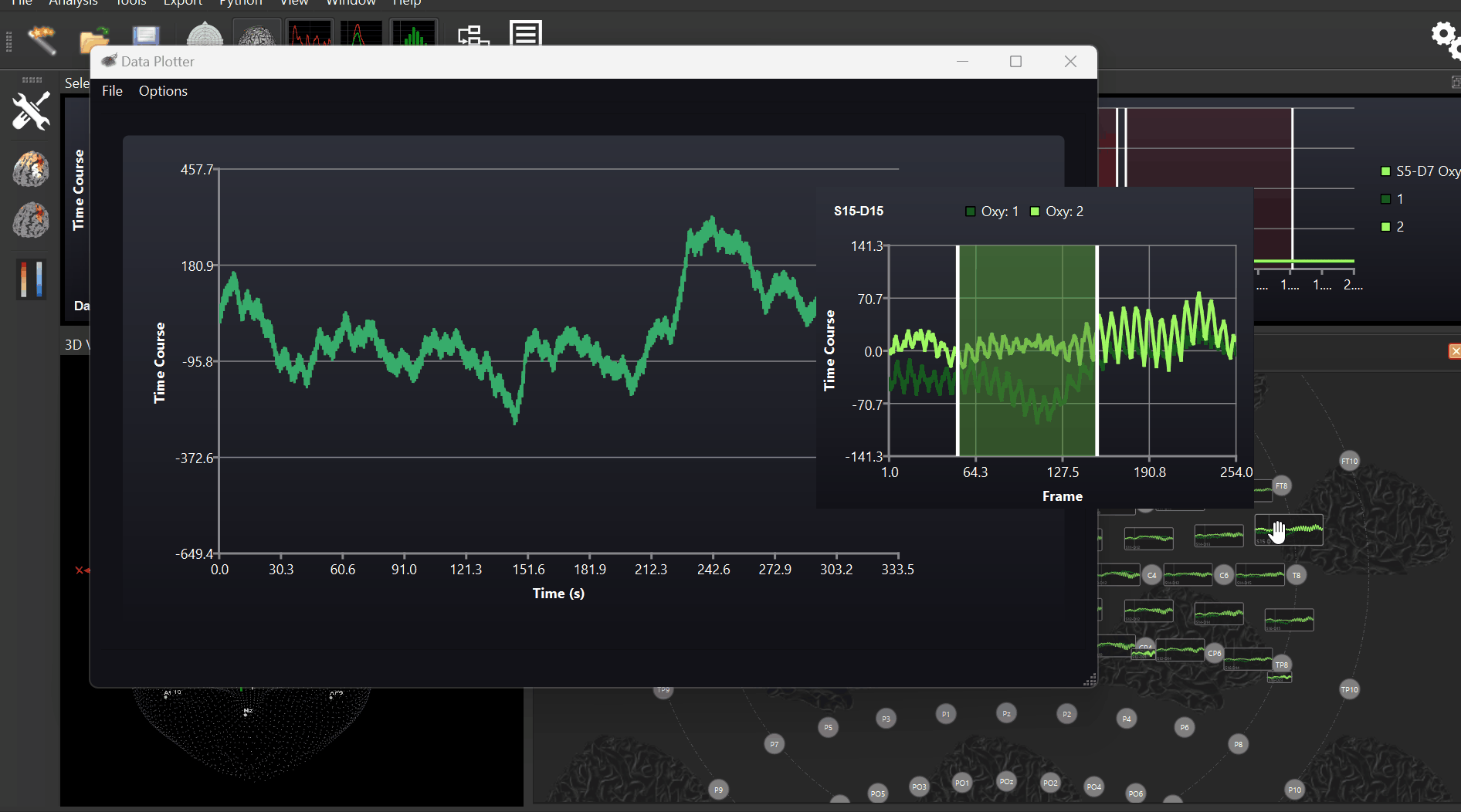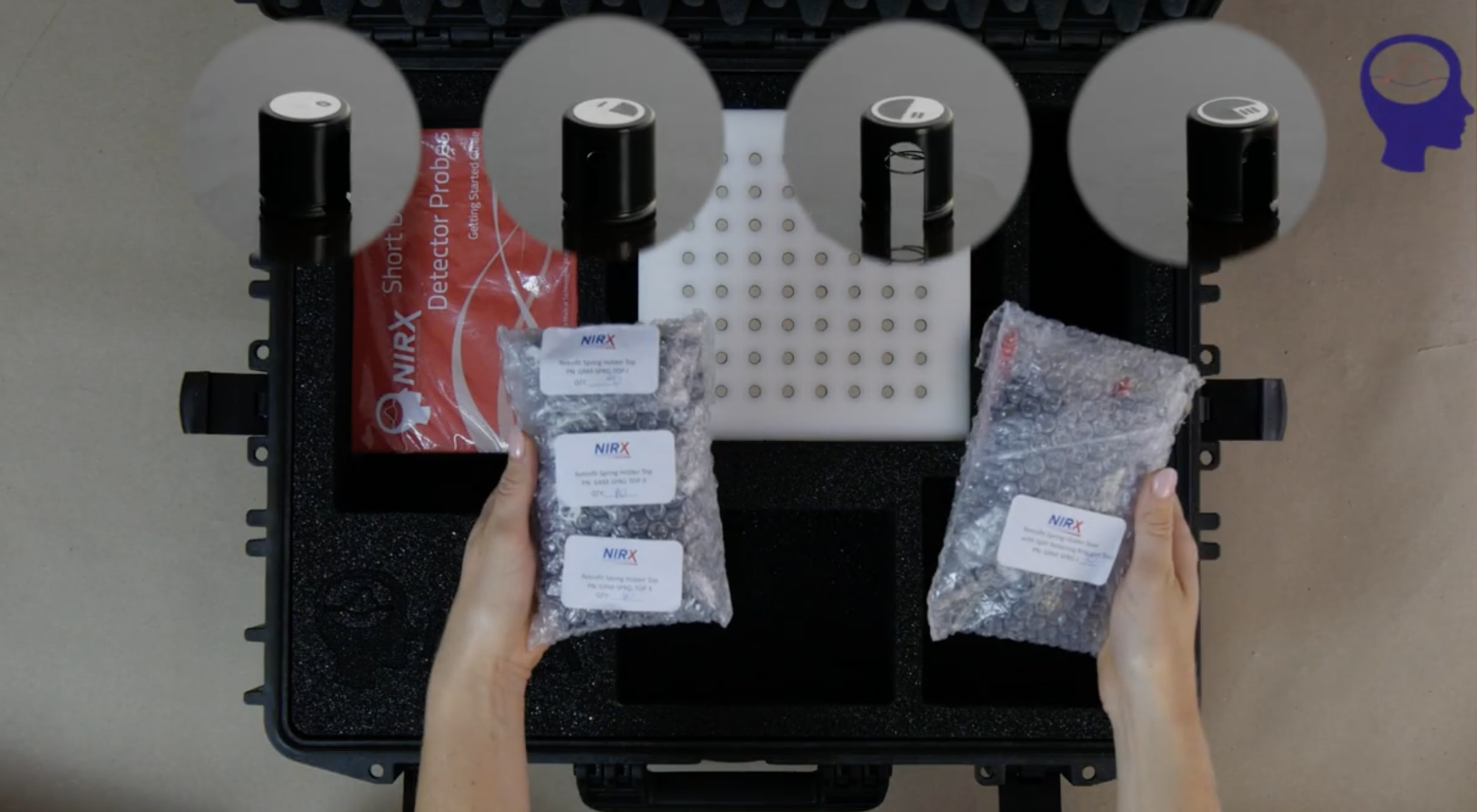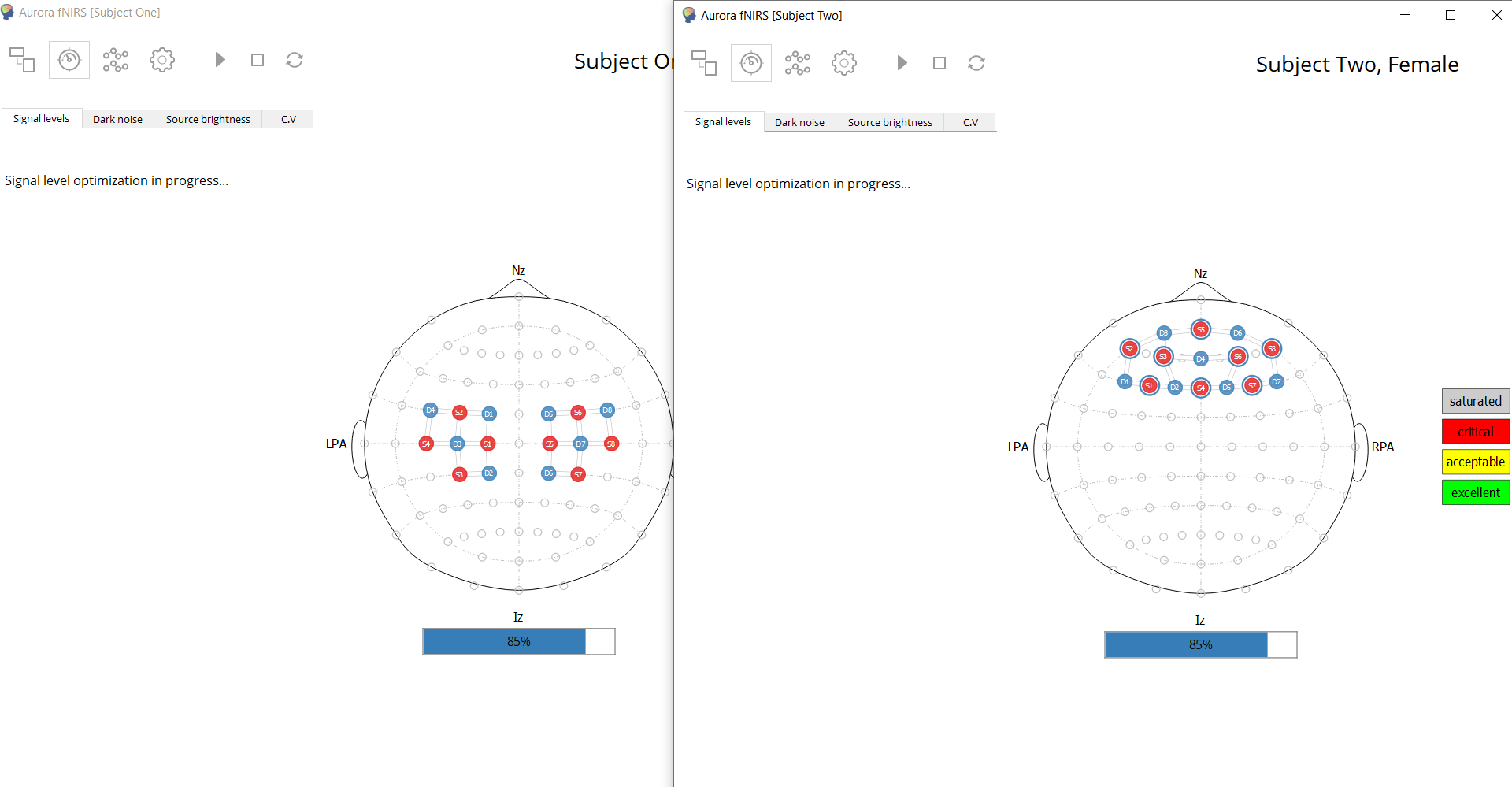NIRx and Artinis join forces to accelerate innovation in brain imaging
Beyond the Brain: Physiological Signals in fNIRS Research
Functional Near Infrared Spectroscopy (fNIRS) is a flexible and non-invasive imaging technique, making it particularly attractive for studies in naturalistic, mobile, and social environments. One of the major advantages of fNIRS is the ease with which it can be combined with other modalities such as peripheral physiology. Indeed, recent progress in fNIRS methods has identified two ways that physiological data can be incorporated into fNIRS analyses.
First, fNIRS is designed to measure the cerebral hemodynamic responses evoked by neural activity. However, as the technique measures light absorption through both cerebral and extracerebral tissues, systemic physiological processes, such as cardiac pulsation, respiration, and autonomic fluctuations, can significantly contaminate the signal (Figure 1). Addressing these confounds is therefore critical for accurate interpretation.
Figure 1: A graphic of the physiological signals reaching the detector and their origins. Functional brain activity comes from the cerebral cortex, but respiration, cardiac, and Mayer wave data reaching the detector come from both the cerebral and extracerebral layers. Sensors measuring systemic signals in the body, such as EMG, respiration, and short-distance detectors, can help remove those artefacts.
The second application of combined fNIRS-peripheral physiology integrates both in order to investigate the brain-body relationships by examining how peripheral physiology interacts with neural responses (joint analysis).
This dual motivation, cleaner data and richer insights, has led to growing interest in what is now termed Systemic Physiology-Augmented fNIRS (SPA-fNIRS) (Scholkmann et al., 2022). The following sections discuss the nature of these physiological confounds, the methods used to address them, examples of SPA-fNIRS in recent publications, and how the NIRxWINGS2 system facilitates both robust denoising and advanced multimodal research paradigms.
SPA-fNIRS for Denoising
fNIRS captures light absorption through tissue, and that means it also picks up non-neural signals from the scalp, skin, and superficial vasculature. As Tachtsidis and Scholkmann (2016) explain, these systemic influences can introduce false positives or negatives, distorting experimental results (Figure 2). Even subtle changes in heart rate variability or respiration can shift the fNIRS baseline, mimicking brain activation or obscuring it entirely.
Figure 2: Visualization of the six components of the fNIRS signals. (a) An incorrect assumption is that the fNIRS signal represents only changes associated with functional brain activity due to neurovascular coupling. (b) In reality, the fNIRS signals comprise six components, so that five components are potentially confounders in every fNIRS study. The contribution of the components to the fNIRS signal is visualized by color-coding (red: 100%, white: 0%). As the figure shows, four of these five potential confounds relate to systemic signals of the sort measured by the NIRxWINGS2. From Tachtsidis and Scholkmann (2016).
Peripheral Signals vs Short Channels
To combat this issue, physiological signals can be measured concurrently and used to model and regress out non-neural variance (Figure 3). In fNIRS, there are two primary approaches to measuring systemic influences: short-distance detectors capture extracerebral systemic signals (see our webpage on short distance detectors) but by definition do not measure from the cerebral compartment, while dedicated peripheral physiology sensors directly measure specific physiological modalities, potentially allowing for the removal of cerebral and extracerebral systemic signals. Indeed, these approaches are complementary and can in principle be combined. This integration leads to cleaner fNIRS data.
As von Lühmann et al. (2020) demonstrated using advanced signal separation methods, adding peripheral signals alongside short channels led to improvements of 12–16% across a set of data quality metrics. Likewise, Gugliemini et al. (2025) showed that the impact of changes in breathing was not fully captured by short-channel data, but could be accounted for with additional peripheral signals.
However, collecting and synchronizing these signals has historically been a technical hurdle.
NIRxWINGS2: Seamless Systemic Physiology Integration
NIRxWINGS2 is NIRx Medical Technologies’ dedicated module for capturing peripheral physiological data alongside fNIRS. Designed as an extension for the NIRSport2 system, NIRxWINGS2 empowers researchers to conduct SPA-fNIRS with minimal setup complexity.
Figure 3: NIRxWINGS2 wearer equipped with respiration belt, bipolar EMG sensors, PPG, GSR, temperature sensor, and two NIRSport2s with 32x32 source-detector montage. (NIRx, 2025)
What NIRxWINGS2 Measures
Respiration – Chest expansion and breathing rhythm
Electrodermal Activity (EDA/GSR) – Sympathetic arousal
Skin Temperature – Peripheral vasodilation/constriction
Pulse Oximetry (PPG) – Heart rate and SpO₂
Bipolar signals such as EMG and ECG – Muscle and cardiac activity
All data streams—including triggers— are fully synchronized within the NIRx Aurora software, eliminating the traditional headaches of integrating multiple systems. Wireless data transmission and onboard storage allow participants to move freely, even outside the lab, while still capturing high-quality multimodal datasets.
SPA-fNIRS Enriches fNIRS Experiments
Figure 4: Participant in the Li et al. 2024 study on developing a human-machine trust evaluation method for High-Speed Train Drivers
Recent research demonstrates the power of Systemic Physiology-Augmented fNIRS (SPA-fNIRS) to capture complex interactions between brain activity and peripheral physiological signals.
Examples of Recent SPA-fNIRS Research
Li et al. (2024) developed a trust evaluation method for high-speed train drivers using multimodal physiological signals to enhance human-machine interaction safety.
Khazaei et al. (2024) describe a rich multimodal dataset of ECG, respiration, skin surface temperature, skin conductance (EDA), PPG, EMG, and facial expressions with fNIRS to investigate working memory under music stimulation.
Guglielmini et al. (20222025) used SPA-fNIRS to track hemodynamics, peripheral physiology, and the interplay between the two during a social interaction task.
Peng et al. (2024) explored how real-time physiological metrics can inform pain monitoring under anesthesia using advanced fNIRS modules.
Wu et al. (2024) examined neuromuscular control post-exercise cold water immersion on neuromuscular control through integrated neuroimaging and EMG.
Sheng et al (2025) integrated surface EMG and fNIRS data to investigate the effectiveness of walking-conversion training in a clinical trial with stroke patients.
Angioletti et al. (2025) demonstrated how brain activity and peripheral autonomic responses work synergistically during persuasion in shared decision-making contexts in a hyperscanning study.
The NIRxWINGS2 system can facilitate these approaches by seamlessly synchronizing peripheral signals such as respiration, electrodermal activity, and pulse oximetry with fNIRS data, enabling researchers to uncover richer, more accurate insights into brain-body dynamics.
By integrating SPA-fNIRS with NIRxWINGS2, researchers can capture a comprehensive picture of both brain activity and peripheral physiological signals, not only ensuring cleaner data but also enabling deeper insights into the dynamic interplay between neural processes and bodily states across diverse real-world applications. Reach out to our consulting team to find out how the NIRxWINGS2 can impact your research.
References
Angioletti, L., Acconito, C., Saquella, F., & Balconi, M. (2025). Central (Hemodynamic) and Peripheral (Autonomic) Synergy During Persuasion Within a Shared Decision-Making Process. Applied Sciences, 15(3), 1361.
Guglielmini, S., Bopp, G., Marcar, V. L., Scholkmann, F., & Wolf, M. (2022). Systemic physiology augmented functional near-infrared spectroscopy hyperscanning: a first evaluation investigating entrainment of spontaneous activity of brain and body physiology between subjects. Neurophotonics, 9(2), 026601.
Guglielmini, S., Wiggli, E., Scholkmann, F., & Wolf, M. (2025). Hemodynamics and vascular oxygenation measured at the forehead during changes in respiration: A SPA-fNIRS study. Respiratory Physiology & Neurobiology, 331, 104364.
Khazaei, S., Parshi, S., Alam, S., Amin, M. R., & Faghih, R. T. (2024). A multimodal dataset for investigating working memory in presence of music: a pilot study. Frontiers in Neuroscience, 18, 1406814.
Li, H., Liang, M., Niu, K., & Zhang, Y. (2024). A Human-Machine Trust Evaluation Method for High-Speed Train Drivers Based on Multi-Modal Physiological Information. International Journal of Human–Computer Interaction, 41(4), 2659-2676.
Peng, K., Karunakaran, K. D., Green, S., & Borsook, D. (2024). Machines, mathematics, and modules: the potential to provide real-time metrics for pain under anesthesia. Neurophotonics, 11(1), 010701-010701.
Scholkmann, F., Tachtsidis, I., Wolf, M., & Wolf, U. (2022). Systemic physiology augmented functional near-infrared spectroscopy: a powerful approach to study the embodied human brain. Neurophotonics, 9(3), 030801-030801.
Tachtsidis, I., & Scholkmann, F. (2016). False positives and false negatives in functional near-infrared spectroscopy: issues, challenges, and the way forward. Neurophotonics, 3(3), 031405-031405.
von Lühmann, A., Boukouvalas, Z., Müller, K. R., & Adalı, T. (2019). A new blind source separation framework for signal analysis and artifact rejection in functional near-infrared spectroscopy. Neuroimage, 200, 72-88.
von Lühmann, A., Li, X., Müller, K. R., Boas, D. A., & Yücel, M. A. (2020). Improved physiological noise regression in fNIRS: a multimodal extension of the general linear model using temporally embedded canonical correlation analysis. NeuroImage, 208, 116472.
Wu, Y., Qin, F., & Zheng, X. (2024). The Effects of Post-Exercise Cold Water Immersion on Neuromuscular Control of Knee. Brain Sciences, 14(6), 555.
Introducing NIRxWINGS2: The Next Generation of Physiological Sensing
We’re excited to officially launch NIRxWINGS2 – the next evolution in physiological sensing technology for multimodal fNIRS neuroimaging. Designed in response to direct feedback from our global user community, NIRxWINGS2 brings upgrades in signal quality, flexibility, and mobility to your fNIRS studies.
Whether you're investigating cognitive function, stress and attention in dynamic environments, or designing advanced neuroergonomic paradigms, NIRxWINGS2 is your tool for combined physiological and fNIRS measurements.
In this blog post, you will find some of the features and advancements NIRxWINGS2 offers your research!
Like its predecessor, NIRxWINGS2 is designed to extend the NIRSport2 and comes with sensors for respiration, ExG (e.g., EMG, EOG, ECG), temperature, PPG, and electrodermal activity (EDA/GSR). However, the new universal sensor port offers more flexibility for your research.
Full Customization with the NIRx BioLink
The NIRx BioLink universal sensor port introduces a flexible system that adapts to your research now and in the future.
Mix & match sensors: ExG (e.g., EMG, ECG), respiration, temperature, and EDA
Color-coded sensors for fast, mistake-free setup
Auto-recognition via our Aurora software streamlines configuration
Ready for future sensor types—your research is future-proof!
No matter your study design, you’re in control.
Smarter Sensors, Cleaner Data
With NIRxWINGS2, signal fidelity takes a leap forward. The EDA, respiration, and temperature sensors have been refined to deliver cleaner, more reliable outputs in even the most dynamic settings:
EDA: Redesigned circuit for improved signal quality
Respiration: Inductive sensor belt minimizes motion artifacts
Temperature: Thermistor-based sensor provides real-time responsiveness
Shielded cables reduce cross-talk for high-fidelity signals
Built for the Real World
Research doesn’t always stop at the lab door, so why should your tools? Combining the NIRxWINGS2 + NIRSport2 means compact, lightweight, and wireless solution for fully mobile multimodal recordings:
Wireless connectivity & internal storage
Real-time synchronization of physiology + fNIRS via LSL stream
Robust performance in high-movement, multi-sensory environments
Ideal for studies in sports science, mindfulness, VR, learning, and more
Take your setup into classrooms, clinics, workplaces, or the great outdoors.
See It in Action – Join Our Webinar
Curious how NIRxWINGS2 can elevate your work? Don’t miss our upcoming live webinar, where we’ll showcase:
How to set up your custom configuration with NIRx BioLink
Strategies to improve data quality across modalities
Real use cases from our global research community
Live Q&A with our NIRx expert support team!
📅 Date: May 28th, 2025
⏰ Time: 4-5 pm, GMT + 2
🔗 Register via Zoom
Tutorial Video Series: Take your Research to the Next Level with Satori!
As an fNIRS researcher, you understand the importance of staying at the forefront of knowledge and technology. To this end, NIRx Medical Technologies and Brain Innovation launched in 2022 an innovative software product called Satori. Satori is an easy-to-use and powerful fNIRS analysis software. It includes the current standard fNIRS processing methods and statistical tools. Check out a recent overview video here.
As part of a commitment to support our customers, we have created a comprehensive playlist of training videos for researchers starting out with this state-of-the-art software. From setting up preprocessing pipelines to accessing data analysis tools, this Tutorial Series provides a clear overview of the Satori interface, enabling researchers to maximize their efficiency. In this blog post, we will take a look at what you can expect from these videos. We hope they can help you get started with Satori and bring you closer to your next publication.
Mastering the Satori Interface
The Satori software tutorial series begins with an introduction to the user interface, ensuring that researchers become familiar with its features and functionalities. This helps users navigate through the software with ease, saving valuable time and streamlining their workflow. There is a clip describing the event manager where users can easily edit their experimental paradigm ready for preprocessing and analysis.
The videos also guide users through the workflow manager in which all Satori’s features such as transformations, preprocessing, post-processing, and analysis steps, can be dragged into a clear visualisation tool. This can be easily shared with your collaborators.
Data preprocessing and analysis
One of the most valuable aspects of Satori's software tutorial series is the focus on data preprocessing and analysis methods readily available within the software. These techniques are based on the most common and robust methods in the literature. The videos offer guidance on preprocessing options specific to your data. Researchers are shown the built-in methods like temporal filtering, short channel regression (in both preprocessing and analysis), normalization, channel rejection, and motion correction parameters such as TDDR (temporal derivative distribution repair), CBSI (correlation-based signal improvement), and spike correction. You can also learn how to configure each option in advanced settings.
These videos also provide information on how to analyse experiments within Satori. With the tutorial on running a single study GLM, users are shown how to set up the analysis, manage statistical parameters and thresholds, setting contrasts and including confound regressors. Satori is also able to run multi-study GLM analysis, SVM training, cross- and anti- correlation.
Advanced Data Visualization and Interpretation
Data visualization is key to effectively communicating research findings. With Satori, this is accessible in just a few clicks. Satori's software training videos provide researchers with a quick overview of the data visualization techniques included. Part 2 of the single study GLM tutorial gives an example of how these visualization tools can be leveraged to transform complex data sets into clear, insightful visual representations with simple customization options for thresholds. These channel maps, graphs, and images can then be easily exported. These videos teach scientists how to display their data in a visually appealing manner within Satori, enhancing the dissemination and understanding of their research.
Extend Satori 2.0 with Python
We are excited to announce that the latest release, Satori 2.0 has inbuilt integration with Python. You can expand the capabilities of the software with your own scripts! We hope this interoperability empowers researchers to combine the strengths of Satori with other tools you may already be using, fostering a flexible and tailored approach to your research projects. Check out our recent webinar on these new features of Satori.
Conclusion
Scientific research is a dynamic and ever-evolving field, and staying ahead requires continuous learning and the adoption of cutting-edge technologies. Satori empowers researchers to get to the heart of their data with ease, without having to code a single line.
From mastering the software interface to preprocessing, analysis, advanced visualization, and integration with third-party tools, Satori's tutorial videos offer a helpful resource for researchers, equipping them with the skills and knowledge necessary to unlock their full potential with this fNIRS software.
Take your research to the next level with Satori! Subscribe to our Youtube Channel for more videos to come as features are added to Satori or contact us at consulting@nirx.net to find out more.
New Aurora with advanced multiplexing for high-density fNIRS
by Dr. Alexander von Lühmann
What is High-Density fNIRS and Diffuse-Optical Tomography, and why should we care?
In recent years, we have witnessed a comeback of High-density fNIRS studies. Dr. David Boas discusses the recent advances and perspectives in this 2 part-webinar.
HD-fNIRS can improve spatial resolution, depth, and lateral specificity, and can enable image reconstruction of cerebral activation (Diffuse Optical Tomography, DOT).
DOT fNIRS research was initially only done by a small number of experts in the field because it requires special infrastructure, such as many channels, high dynamic range instrumentation, and photon migration simulation algorithms.
DOT fNIRS systems have become more accessible and open toolboxes make it much easier to perform image reconstruction of the data. Here’s a walkthrough of the NIRStoolbox by Dr. Theodore Huppert.
"What are the trade-offs to achieve high-density measurements?"
Excellent signal quality and a good sampling rate are basic requirements for fNIRS research, regardless of conventional or high-density measurements. To achieve high-quality recordings, a trade-off between several challenges has to be addressed:
A high dynamic range is needed to measure channels at short and long source-detector distances. Long channels need brighter sources to see good signal, but brighter sources can saturate short channels, reducing signal quality.
With multiple sources closely packed, avoiding crosstalk is a must. Pure time-multiplexing (turning one source on at a time) in a high-density setup reduces the sampling rate.
The new Aurora: Multi-Level Illumination and Extended Frequency Encoding
We solved these issues above by unlocking two powerful new features of the NIRSport2 with Aurora: Multi-Level Illumination (MLI) and Extended Frequency Encoding (EFE).
Multi-Level Illumination now enables each source to be used multiple times with different intensities in the same measurement cycle.
This way, optimal signal quality can be achieved despite differences in source-detector distances between channels! The result: optical signal quality at an even higher dynamic range, locally optimized.
Diagram showcasing one use case of the MLI feature. If a source has channels at short distances (e.g. <20 mm short separation channels) and at long distances (e.g. usual >30 mm channels), detectors that are too close to a light source might be “blinded” by the amount of light needed to reach the longer channels. By splitting the source illumination sequence into two parts with different light levels, it is possible to first: (A) use lower-powered light to optimally reach detectors at shorter distances; and then (B) use higher-powered light to optimally reach detectors at longer distances.
Extended Frequency Encoding increases the number of simultaneously used frequencies for signal (de)modulation from two to eight.
What does this mean? More sources close by one another can be turned on at the same time without affecting signal quality by creating crosstalk. This saves precious time switching steps and therefore doubles the available sample rate.
Smart Optimization feature: Both MLI and EFE do not have to be configured by the user.
If enabled, our new Smart Optimization feature automatically figures out the best signal quality and sample rate that can be achieved with your montage.
In summary: Your NIRSport2 gets an upgrade for high-density and higher sample rates, both without making any compromises on the outstanding signal quality that the system is known for. We further empower you to perform DOT fNIRS-based tomographic image reconstruction within our NIRSport2 platform.
Get in touch with us at consulting@nirx.net to find out more
Discover the Power of Satori 2.0: New Features Unveiled!
We are excited to announce the upcoming release of Satori 2.0 in mid-August!
Since the first launch of Satori in 2022, Brain Innovation and NIRx have been collecting feedback from fNIRS scientists about the most important features to include in the next version of the software. With Satori 2.0, we are thrilled to introduce these new and updated features that will enhance your data preprocessing and analysis capabilities. For summaries of the features already available in Satori, check out our tutorial series on YouTube.
In this blog post, we will delve into three key additions:
Python Based Solutions,
The data plotter,
Integrated user guides.
So let's dive in and explore the possibilities of Satori 2.0!
1. Python Integration
One of the most prominent additions are the Python functions executable within the Satori User Interface. Not only can you harness the power of existing Python algorithms and features, but you can also develop and include custom functionalities. This extensibility allows for the rapid expansion of fNIRS algorithms and the incorporation of novel features developed by the scientific community.
There are two ways Python is integrated into Satori. With the Python Scripts directly executable from the Satori header menu, you can take full control of your data processing pipelines.
In the Workflow Manager, you can load data and seamlessly incorporate Python Based Workflow Modules which are pre-processing or post-processing the data. We have already included some example scripts which are supported by NIRx and Brain Innovation and documented in the integrated user guide.
2. Data Plotter
Satori 2.0 introduces an exciting new feature, the data plotter. In the data plotter, you can load datasets and view multiple channels simultaneously. While the Selected Channels view allowed for the viewing of multiple channels within a dataset, Satori 2.0 takes it a step further by enabling the visualization of channels from different datasets and the ability to include or exclude specific processing steps. By comparing different pre-processing steps, zooming in on time series data, and toggling the visibility of channels, you gain deeper insights into your data, quickly and easily. The data plotter also allows you to add peripheral physiology, such as data from NIRxWINGS, for a comprehensive analysis.
Of course, Satori 2.0 also brings enhancements to the user interface GUI, making your data analysis experience even more seamless. With improved window scaling, navigating through your data becomes more intuitive and efficient. Beyond the data plotter, additional data and analysis results viewing options are now available.
3. Integrated User Guide
We are excited to announce that improved documentation features accompany each processing step in the modules in the workflow manager and certified Python scripts. This is part of our commitment to equip users with the knowledge, instructions, and resources they need to effectively navigate the software and processing steps. To this end, we also have released a series of training videos available on our YouTube channel. With this comprehensive documentation, we hope users can quickly understand the functionalities of, and concepts behind Satori's data analysis tools.
Conclusion
With the introduction of the data plotter, Python integration, and in-built user guides, Satori 2.0 empowers users to clearly view time series data, customize their workflows, and enjoy an improved user experience. Satori 2.0 will be available in mid-August, contact us at consulting@nirx.net to see how this powerful software could impact your research. Happy data crunching!
Satori 2.0 Introductory Webinar
In August 2023, Dr. Jeremy Burnison from NIRx and Michael Lührs from Brain Innovation gave an overview of Satori and introduced the new Satori features provided with version 2.0.
Satori EDU Launched!
Experience the free educational version of the state-of-the-art fNIRS processing and analysis software
One year has passed since we released the first version of the Satori, and we are incredibly proud and thankful for the overwhelming interest we received.
During this year, Brain Innovation has been working hard to keep the software up-to-date with the most recent analysis techniques and to optimize each feature, making the software as user-friendly as possible. We would like to thank everyone who contributed with their feedback!
As one of our aims is to make fNIRS data analysis accessible, we decided to create a free educational version of Satori. Satori EDU has all the standard software features and has predefined datasets so this version can be used for educational purposes. This software version helps people learn fNIRS data analysis one step at a time. It comes with a Getting Started Guide that shows how to load and visualize your data, inspect the quality, preprocess, run statistical tests on the data, then extract your results.
Upcoming Webinars
For a glimpse of the newest functionalities, please watch our latest webinar. NIRx and Brain Innovation will also be hosting a live webinar about the new features available in the newest versions of Satori. Join us online January 26th 4.30 UTC.
More to come!
We are working hard on the next milestone release of Satori which will include great new features such as Python integration and pre-processing functions to integrate physiology in your data analysis. We look forward to further innovate in making fNIRS data analysis accessible.
If you are interested in using Satori EDU for your university course or training your lab members, do not hesitate to contact us at consulting@nirx.net!
How do I optimize my signal quality?
We are excited to share with you our latest video from our expert colleagues here at NIRx. In this latest release, Demetris take us step by step through the Signal Quality Guide. This guide provides you with the tips and tricks to make sure your signal quality is excellent before beginning your experiment.
This video goes through how to quantitatively and qualitatively assess signal quality.
In Part 1, Demetris takes us through how to assess signal quality. Part 2 shows how to troubleshoot the challenges when things are less than perfect. These two sections follow the Signal Quality Guidelines, available as a PDF on our Support Site. In Part 3, with the help of our colleagues, we show a real-time example of set up, checks, and troubleshooting.
Um Workshop de fNIRS na America latina / fNIRS Workshop in Latin America!
Written by: Cesar Noronha, M
Pictures: Mariana Ceci/Ascom ISD
(Português abaixo)
fNIRS Workshop in Latin America!
2022 started off on the right foot in Latin America with workshops for participants from all regions of Brazil!
In February, NIRx, together with Brain Support, and Instituto Santos Dumont, hosted a two-day workshop with presentations and hands-on sessions. This event featured morning lectures and practical sessions in the afternoons.
Maria Adelia presenting the hands-on session.
In the mornings, international speakers were invited to talk about their fNIRS research. They introduced advantages of fNIRS, challenges, experimental design, special considerations and analyses. On the last day, NIRx held a closing talk discussing the fundamentals of fNIRS.
Cesar Noronha setting up the NIRS cap.
In the afternoons, there were practical sessions demonstrating NIRSport2 data acquisition on the first day, and NIRSport1 on the second day. This was all streamed online.
After the sessions, we worked with each research group on their specific questions and challenges. The focus of the first day was the assembly design and data acquisition and the second day was the analysis and interpretation.
Representatives of at least 4 different research groups that use or want to use fNIRS in their research were present. We love to share fNIRS technology. Check out our webinars or events pages for more upcoming workshops.
The lectures are in Instituto Santos Dumont open YouTube channel for sharing:
NIRx Staff - Maria Adelia de Aratanha, Cesar Noronha
Brain Support Staff - Daniel Machado
Um Webinar de fNIRS na America latina!
Iniciamos 2022 com o pé direito na américa latina! Realizamos seminários com convidados de varias regiões do Brasil!
Em Fevereiro os pesquisadores e entusiastas de fNIRS da America Latina tiveram um evento para chamar de seu. A NIRx junto da Brain Suport e o Instuto Santos Dumont realizaram um webinar de dois dias com apresentações e sessões de hands-on!
Maria Adelia explains the multiplicity of fNIRS systems
Este foi um workshop de dois dias muito interessante. Tivemos palestras inteiras de manhã e NIRx e sessões práticas durante as tardes. Pela manhã tivemos palestrantes internacionais falando sobre suas pesquisas com fNIRS, desafios, vantagens, desenho experimental, considerações especiais e análises. No último dia, o NIRx realizou uma palestra de encerramento falando sobre os fundamentos do fNIRS.
Na parte da tarde, tivemos uma sessão prática gravada onde mostramos a aquisição de dados NIRSport2 no primeiro dia e NIRSport1 no segundo dia. Após a sessão gravada, trabalhávamos com cada grupo de pesquisa em suas questões e desafios específicos. O foco do primeiro dia foi o desenho da montagem e aquisição de dados e no segundo dia foi a análise e interpretação.
Researchers from different laboratories discuss an experimental design proposed during the seminar
Tivemos a presença de representantes de pelo menos 4 diferentes grupos de pesquisa que utilizam ou utilização fNIRS em suas pesquisas. Os pesquisadores presentes além de elogiarem bastante o webinar já perguntaram quando será o próximo!
As palestras estão no canal do YouTube do Instituto Santos Dumont aberto para compartilhamento:
The Latin America fNIRS community in attendance
Thank you to all who attended! See you next time!
A Practical Guide for fNIRS and EEG
How do you combine fNIRS and EEG? And why should you?
Forward written by Brain Products
Combining different neurophysiological technologies offers the possibility of examining cortical activity in a more comprehensive compared to one modality alone. In particular, the co-registration of EEG and fNIRS has a series of functional and practical advantages, since they capture different but complementary aspects of the brain’s activity.
EEG directly measures the fast changes in electrical activity connected to neuronal function. This signal has an exquisite temporal resolution (millisecond precision) but limited spatial resolution. fNIRS measures changes in the brain’s hemodynamic response, and, specifically, localizes the slower changes in oxygen metabolism that follow neural activation. This signal has a good spatial resolution (<1 cm) but a limited temporal resolution (~ 3 to 6 seconds).
Besides being complementary to each other, an additional advantage is that EEG and fNIRS signals do not interfere with each other, making data recording and analysis more straightforward than with other modalities (e.g. fMRI, MEG). While EEG uses electrodes to measure scalp potentials, fNIRS uses optodes (light sources and detectors) to measure cortical hemodynamic response.
How to combine EEG and fNIRS, a practical guide
We have written a practical step by step guide that details how to conduct an EEG and fNIRS experiment using the examples of NIRx and Brain Products devices. Download your free copy below. It is also available on the NIRx Support Site for Customers.
fMRI + fNIRS with the NIRxBorealis
The new imager from NIRx with all the advantages of the NIRSport2
NIRxBorealis combines the NIRx flagship NIRSport2 amplifiers with fiber-based laser stimulation and APD detectors. This allows concurrent fMRI and fNIRS recordings and then the co-analysis of fNIRS and fMRI results. It also allows directly running the very same fNIRS experiment fully mobile outside the scanner at a fraction of the cost.
Advantages
Flexibility to use the popular NIRSport2 platform for both mobile and MRI-integrated experiments
Coupling two NIRSport2 via Laser and APD cards into MRI compatible fiber optics
Data saved in the .snirf file format, a modern standard to facilitate data sharing
Supporting latest Aurora release
Applications
The use of optical fiber based optodes for combining fNIRS with fMRI serves impactful research applications, and combining the two modalities aids the validation of the complementary signals.
Compared to the deoxy-Hb based signal of fMRI, fNIRS separately measures deoxy-Hb and oxy-Hb which provides further information about hemodynamics and can improve the fMRI signal quality. Additionally, combined fNIRS-fMRI multimodal imaging studies can assess the congruence between full-body behaviors with fNIRS and analogous stationery designs with fMRI, thereby extending research into more ecologically valid settings.
See how it works and book a demo with us here: nirx.net/contact
Want to know more about this product?
Send us an e-mail at support@nirx.net
LatAmNIRS Virtual Meeting 2021
Um encontro virtual de sucesso para a comunidade de NIRS da América Latina / A successful virtual event for the Latin American NIRS community!
A LatAmNIRS foi muito boa! A reunião aconteceu durante um único dia recheado de apresentações de pesquisadores do mundo todo em português e espanhol.
O dia foi dividido em quatro seções, cobrindo Instrumentação, Aplicações em neurociência, Análise de dados e aplicações clinicas. A palestra de abertura, ministrada pela Prof. Debora Marques de Miranda (Universidade Federal de Minas Gerais, Brasil), abordou insights a respeito de bebes em desenvolvimento. Já a palestra de encerramento, ministrada pelo Prof. Luca Pollonini (University of Houston, USA/EE.UU), abordou sobre orientações para que uma pesquisa em fNIRS seja bem sucedida.
Além disso, a reunião contou com um workshop oferecido pela BrainSupport, que trouxe palestras sobre desenhos experimentais, sobre as mais atuais toolboxes para análise de dados de fNIRS, e com uma demonstração ao vivo de uma medida de NIRS com o sistema NIRSport2 da NIRx em conjunto a medidas de fisiologia extracerebral usando o mais novo produto da empresa, o NIRxWINGS.
The LatAmNIRS 2021 virtual meeting was a blast! It featured a single day packed with talks in Spanish and Portuguese from speakers from all over the globe.
The day was split into four main sessions covering Instrumentation, Neuroscience Applications, Data analysis, and Clinical Applications. The opening talk was given by Prof. Debora Marques de Miranda (Federal University of Minas Gerais, Brazil), who shared her research insights on developing babies using NIRS, while the closing talk was conducted by Prof. Luca Pollonini (University of Houston, USA/EE.UU), who presented guidelines for successful fNIRS investigations.
In addition to that, the meeting also held a workshop offered by BrainSupport. This featured lectures on experimental design, the latest fNIRS analysis toolboxes, and a hands-on live demonstration of a NIRS measurement using a NIRx NIRSport2 system. We also demonstrated how physiological measurements can be concurrently measured with our, the NIRxWINGS.
See you next year!
NIRx Accessory Kits - Explainer Videos
What accessories can you expect with a fNIRS device from NIRx?
It’s arrived! What can you expect included in the delivery of your NIRx fNIRS system?
We have made some videos that give a walk-through of the items that will arrive in two of the three cases. These are the Starter Kit and Cap Kit. In these kits you will find everything that you need and more to prepare and run your fNIRS experiments with NIRx devices.
In the Starter Kit you'll find accessories to set up your experiment, these include a tape measure, links, headlamp and more.
In the Starter Kit Video, each item is described and it’s use explained. For example, Velcro straps are used for cable management.
The Cap Kit has all the items necessary for preparing your fNIRS cap. Here you’ll find your NIRScaps, optode holders and bases, short channels, phantom, and much more.
Cap Kit Video: a brief description of each item is given. In this screenshot we talk about the color-coded optode labels.
These clips are intended to get your experiments up and running in no time. We touch on each item in turn, and give a brief explanation of their uses.
In the Cap Kit video we talk through the four different spring holder pressures.
Our extensive Support Site contains information on how to use our solutions . We have helped hundreds of scientists before. Please know that our support is free, and we are always happy to help.
You can reach us at support@nirx.net or talk to your consultant - they will put you in touch with the right expert.
Why Use Physiological Sensors in fNIRS Experiments?
Explaining Variance
In fNIRS recordings, we primarily want to see the signal from the brain. In reality, we also measure non-evoked, systemic activity from the surrounding tissue too (Tachtsidis and Scholkmann, 2016). You can regress out this noise using data from short-channels and physiological sensors. These sensors might include HR, BR, Tonic/Phasic Skin Conductance, Blood Pressure, SpO2 amongst others.
Multi-Modality
Being able to simultaneously measure several global body parameters could enrich your research with more data. It enables you to asses novel mechanisms and concurrent phenomena. A mobile device would allow for naturalistic experiments in complex real-world environments.
Some examples could be: emotional arousal in response to presented stimulus (dos Santos et al 2021), orthostatic hypotension and falls (Mol et al, 2020), cardiac output and respiration (Anh et al, 2016), or concurrent muscle activation (Ortega et al, 2020).
Introducing NIRxWINGS
The NIRxWINGS module for peripheral physiology measurements extends the NIRSport2. Signal processing algorithms can be optimized for artefact rejection (von Lühmann et al, 2019). It enables new experiments and amplifies your datasets with additional biosignal inputs.
Wireless data transfer allows the participant to move freely. Although the device stores data onboard, it also wirelessly streams for real-time display.
Mobililty
With NIRxWINGS, you are able to move outside the lab to conduct systemic physiology augmented fNIRS (SPA-fNIRS). You can access complex, dynamic and multi-sensory real-world environments.
Sensors
Pulse oximetry (PPG)
Heart-rate
Heart-rate variability (HRV),
Oxygen saturation (SpO2),
Respiration,
Temperature,
Galvanic skin response (GSR),
Bipolar signals such as EMG and ECG.
The physiology data from NIRxWINGS coupled with short-channels and motion sensors are highly effective in explaining the error variance in your fNIRS signal.
Check out this page to find more NIRxWINGS features.
Want to know more about this product? Send us an e-mail at support@nirx.net
References:
Tachtsidis, I., & Scholkmann, F. (2016). False positives and false negatives in functional near-infrared spectroscopy: issues, challenges, and the way forward. Neurophotonics, 3(3), 031405. https://doi.org/10.1117/1.NPh.3.3.031405
**Technical References:**
von Lühmann, A., Boukouvalas, Z., Müller, K. R., & Adalı, T. (2019). A new blind source separation framework for signal analysis and artifact rejection in functional near-infrared spectroscopy. NeuroImage, 200, 72-88. https://doi.org/10.1016/j.neuroimage.2019.06.021
von Lühmann, A., Li, X., Gilmore, N., Boas, D. A., & Yücel, M. A. (2020). Open Access Multimodal fNIRS Resting State Dataset With and Without Synthetic Hemodynamic Responses. Frontiers in Neuroscience, 14. https://doi.org/10.3389/fnins.2020.579353
**Use Cases**
Useful to identify user attention, stress, and vigilance, to detect and differentiate evoked systemic physiology in fNIRs.
Ahn, S., Nguyen, T., Jang, H., Kim, J. G., & Jun, S. C. (2016). Exploring neuro-physiological correlates of drivers' mental fatigue caused by sleep deprivation using simultaneous EEG, ECG, and fNIRS data. Frontiers in human neuroscience, 10, 219. https://doi.org/10.3389/fnhum.2016.00219
Ortega, P., Zhao, T., & Faisal, A. A. (2020). HYGRIP: Full-Stack Characterization of Neurobehavioral Signals (fNIRS, EEG, EMG, Force, and Breathing) During a Bimanual Grip Force Control Task. Frontiers in Neuroscience, 14. https://doi.org/10.3389/fnins.2020.00919
Mol, A., Maier, A. B., van Wezel, R. J., & Meskers, C. G. (2020). Multimodal monitoring of cardiovascular responses to postural changes. Frontiers in physiology, 11, 168. https://doi.org/10.3389/fphys.2020.00168
dos Santos, F. R., Bazán, P. R., Balardin, J. B., de Aratanha, M. A., Rodrigues, M., Lacerda, S., ... & Kozasa, E. H. (2021). Changes in Prefrontal fNIRS Activation and Heart Rate Variability During Self-Compassionate Thinking Related to Stressful Memories. Mindfulness, 1-13. https://doi.org/10.1007/s12671-021-01789-0
Welcome Satori - the new fNIRS analysis software from Brain Innovation
Written by Dr. Michael Lührs of Brain Innovation B.V.
We are very happy to present to you the first version of Satori, an analysis software for functional near-infrared spectroscopy (fNIRS) data. Whereas Turbo-Satori, the previous release from Brain Innovation, is designed and optimized for real-time applications such as neurofeedback and brain-computer interface (BCI), Satori aims directly at offline analysis.
It is specifically designed to integrate easily with your research while providing state of the art processing and analysis pipelines.
Satori was first developed as an in-house project to easily preprocess and analyze our own fNIRS data. We quickly realized its potential and are now very happy to be able to make it available for everyone.The usability of the software is thereby one of Satori’s highlights. The fNIRS data can be inspected at any time and visualized in different forms and layouts. Please take a look at the shot below for a first glimpse of Satori.
Having the possibility to inspect multiple views of the data at the same time allows for a much better orientation of the location of specific brain activity. In the example above, you can clearly see more activity on the left hemisphere induced by right-hand finger tapping.
Of course, the windows to inspect the data can be freely arranged and detached from the main window. This allows for a more detailed view as you can see below.
The time course of individual channels can be inspected for the different chromophores (Oxy, DeOxy and Total Hemoglobin). This includes the simultaneous view of event related averages and the whole channel time course. The versatility of Satori allows you to quickly review and understand the fNIRS data before deciding on the most suitable preprocessing and analysis method.
The launch of this first version promises continuous developments, support, and education to make fNIRS more accessible to researchers in the years to come. Stay tuned for future updates of Satori which will include direct access to Python, further developments for the Flow manager (a tool to organize and streamline your preprocessing and analysis).
We are looking forward to an exciting journey together with you!
New Software Updates Aurora + NIRSite
Upcoming webinars : Analysis, Turbo-Satori, NIRS-EEG, Infant imaging with fNIRS, Mobile fNIRS
We are pleased to announce that we have many new webinars scheduled! Several topics will be covered, ranging from data acquisition with real-time processing (Turbo-Satori), advanced analysis techniques, multimodal EEG-fNIRS imaging, infant fNIRS imaging to mobile fNIRS.
Upcoming Webinars
2nd Level fNIRS Analysis with Covariates
Confirmed speakers: Dr. Jessica Gemignani
Overview: In the past, we have given several workshops, talks and webinars on the topic of fNIRS analysis, mostly focusing on the tools currently available. Understanding the general linear model is a significant part of the basics of fNIRS analysis. Little attention has however been given to 2nd level/group-level analysis, which comes with its peculiarities and difficulties. This webinar will explore 2nd level analysis, focusing in particular on the use of covariates and how they can be tested for correlations with the signal change in contrasts across subjects. Tools: NIRS Toolbox / AnalyzIR. For a walkthrough of motion and artifact corrections in the NIRS Toolbox, see here.
Date: Monday, 13 July 2020
Time: 4 pm CET, 10 am EST
Turbo-Satori Webinar I: Getting Started
Confirmed speakers: Aisling Casey (NIRx)
Overview: This webinar will cover how to download, install and get familiar with Turbo-Satori, a comprehensive real-time fNIRS analysis and neurofeedback solution from our partners at Brain Innovation. Dr. Michael Lührs, one of Turbo Satori's creators, will be in attendance to answer your questions. This webinar is in preparation for the Turbo-Satori advanced webinar.
Date: July 22nd (4pm CET, 10am EST)
Turbo-Satori Webinar II: Advanced Analysis
Confirmed speakers: Dr. Michael Lührs
Overview: This advanced webinar on Turbo-Satori, a comprehensive real-time fNIRS analysis and neurofeedback solution, is done in collaboration with our partner, Brain Innovation. Dr. Michael Lührs will be joining us and dive deeper into the new Turbo-Satori release and show some advanced analysis features.
Date: July 27th (4pm CET, 10am EST)
Multi-Modal Integration: EEG & fNIRS
Date: August 2020, exact dates TBD
Time: TBD
Confirmed speakers: Dr. Theodore Huppert, Dr. Phil. Ann-Christine Ehlis, Dr. David Medine, Maria Adelia de Aratanha (NIRx)
The combination of fNIRS and EEG offers the possibility to examine cortical activity more comprehensively. EEG and fNIRS have very different but complementary temporal and spatial resolution: while Evoked Potentials (EPs) detect the cortical response to a given stimulus with high temporal resolution, fNIRS localizes changes in oxygen metabolism that follow neural activation.
EEG and fNIRS are very often applied in multi-modal studies: in this webinar series, we will dive deep into the technical challenges and how these can be overcome as well as the benefits and potential applications of combining the two methodologies.
Part 1: Benefits of multimodal applications. Use cases. Setting up your experiment: optimal paradigm design for multimodal fNIRS-EEG studies.
Part 2: Integrating the set up. Combined fNIRS-EEG montage design for optimal cortical coverage. Practical hints on how to setup the integrated cap for good signal quality. Triggering and synchronization: LSL.
Part 3: Approaches to analysis of fNIRS and EEG data.
Infant imaging with fNIRS
Date: September 2020, exact dates TBD
Time: TBD
Confirmed speaker: Dr. Judit Gervain
This webinar series will focus on the following topics:
Introduction to infant imaging with fNIRS. Advantages and possible limitations. Use cases and applications.
Practical considerations. Working with infants, stabilizing the setup, preventing motion artifacts, experiment duration and setup comfort
The setup. Montage design, optimal SD distances for cortical coverage. Practicalwalkthrough in NIRSite.
Mobile imaging with fNIRS
Date: October 2020, exact date TBD
Time: TBD
Confirmed speaker: Dr. Alexander von Lühmann
This webinar will focus on the challenges of mobile brain imaging and the application of fNIRS. Portable and wearable solutions for mobile imaging: from system set up to signal quality considerations. Preventing and managing motion artifacts.
Upcoming Webinars - Aurora 1.4 and fNIRS with Infants & Toddlers
We are pleased to announce that we have four new webinars scheduled! Three of the four will explore the new features with the recent release of Aurora 1.4 , for use with the NIRSport2 fNIRS Imager. The fourth will discuss considerations for imaging infants with fNIRS, led by two of our own experts in the topic, Dr. Jessica Gemignani and Dr. Afrouz Anderson. Note that registration is only open to NIRx customers. See below for more details, exact dates and registration links!
Upcoming Webinars
Overview of Aurora 1.4 - December 12th, 2019
This is the first of the three upcoming Aurora 1.4 webinar series. It will offer a walk through and basic training of Aurora 1.4, the NIRSport2 fNIRS Imager data acquisition software. Emphasis will be placed on the new features with the Aurora 1.4 release, including a new block average view and improved Wi-Fi connection with an access point router. This webinar will be informative both for current users of the NIRSport2 fNIRS Imager looking to make the most out of this platform for their research, and for those interested in using the NIRSport2 in the future.
The Overview of Aurora 1.4 webinar is scheduled for:
Thursday, December 12, 2019 - 4pm CET, 10am EST
fNIRS Studies with Infants & Toddlers - January 13th, 2020
NIRx’s own Dr. Afrouz Anderson and Dr. Jessica Gemignani share a wealth of experience on infant & child fNIRS imaging studies, from data collection to experimental design and analysis. Both have conducted fNIRS studies with these special populations at prestigious institutions, such as the National Institute for Child Health and Human Development and the Yale-Haskins Laboratories. They will discuss the impact of short distance channels in different ages, point out some montages and brain atlases that are frequently used for infants, among other considerations. They will focus on the neonatal to 4 year old age range.
If you are interested fNIRS imaging with infants and toddlers, you won’t want to miss this talk!
The fNIRS Studies with Infants & Children webinar is scheduled for:
Monday, January 13, 2020 - 4pm CET, 10am EST
High density measurements - Multi-Device mode with NIRSport2 - January 20th, 2020
Are you interested in conducting high density, mobile fNIRS studies? Then this webinar, the second of the Aurora 1.4 series, is one for you! It will detail the hardware and software considerations for cascading multiple NIRSport2 devices together, in order to increase the number of available sources and detectors for a single participant, up from the 16x16 configuration that a single device can offer.
The Multi-Device Mode with the NIRSport2
webinar is scheduled for:
Monday, January 20, 2020 - 4pm CET, 10am EST
Hyperscanning with the NIRSport2 and Aurora 1.4 - February 10th, 2020
This webinar is best suited for researchers interested in implementing Hyperscanning with the NIRSport2 and Aurora platform, whether for current research considerations or for future research possibilities. Hyperscanning refers to imaging multiple participants at the same time, in order to study social interaction. The webinar will walkthrough the new standalone Hyperscan application, which makes hyperscanning with Aurora seamless, and possible to implement completely wirelessly. This is the final installment of the Aurora 1.4 webinar series.
The Hyperscanning with the NIRSport2 and Aurora 1.4
webinar is scheduled for:
Monday, February 10, 2020 - 4pm CET, 10AM EST
Register here through the NIRx Help Center.
fNIRS-based BCIs: Can we catch up?
Brain-Computer Interfaces (BCIs) are strategies used to establish communication between the brain and hardware without the need for any effectors of the body (e.g.: muscles used for movement). Such interfaces can allow communication with and restoration of motor function of, people with disorders such as Amyotrophic Lateral Sclerosis (ALS), spinal cord injury or Locked-in Syndrome (LIS). As well as to allow better control of prosthetic limbs in patients with such prosthetics. While the prevalence of ALS may not be particularly high (there is a homogeneous rate across Europe of about 2,2 cases per 100.000 people [1]), the socioeconomic costs associated with it are significant because of its devastatingly debilitating symptoms. With Europe’s aging population the incidents of ALS have been predicted to increase by approximately 69% by 2040 [2], spelling an unprecedented demand for the development of these technologies.
Of the existing non-invasive modalities for imaging the human brain, EEG, MEG, fMRI and fNIRS have all been used in BCI research. Due to its relatively low cost, portability, safety and resilience to electrical noise, the latter has been gaining more and more users ever since its suitability for the purpose was proven [3]. To acquire a readout from the subject’s brain there have been various techniques recruited. Some of the most popular are: (a) Performing mental arithmetic while monitoring the PFC, and, (b) Using motor imagery while monitoring the activity of the motor cortex. These actions can be associated with one answer in a binary paradigm (e.g.: ‘yes’) while relaxation can signify the other (e.g.: ‘no’). A still from a participant undergoing one such experiment is shown below.
An obvious limitation of fNIRS as a tool for BCIs is its poor temporal resolution. Questions which are amenable to a binary answer are not usually very illuminating regarding one’s internal state, meaning that the paradigm needs to move fast if it is to facilitate meaningful communication. Similarly, if a speller is to be used to allow patients to construct sentences, alternative choices will be numerous and long waiting times needed for the haemodynamic response to develop may end up making the process daunting.
Figure was taken from the publication Borgheai et al., 2019. It shows the experimental design used for the selection of one letter in the speller created by the group. By using the matrix design the group severely cut down on the required time to choose one character.
In recent attempts to cut down on waiting times, Borgheai et al., 2019 [4], came up with an innovative design which makes use of a visual matrix of letters (see Figure below). Participants were asked to do some mental arithmetic task for 6 seconds when the line or column containing their letter of choice was illuminated. Even though the interval between letter choices was set to six seconds in order to increase the accuracy of the classification, authors reported a good accuracy (approximately 75%) using data from only the first two seconds of stimulation.
This study used a BCI system based solely on fNIRS. However, in many recent publications of the field where a hybrid BCI system (combined EEG and fNIRS) was used, there has been an enhanced classification accuracy reported [5]. This is perhaps not so surprising since EEG is a fundamentally different modality with strengths which complement those of fNIRS. In the future, combining these innovations may well provide a cutting edge for communication and rehabilitation strategies aimed at patients who suffer from conditions which impair the motor system.
References
1. Logroscino, G. et al. Incidence of amyotrophic lateral sclerosis in Europe. Journal of Neurology, Neurosurgery and Psychiatry 81, 385–390 (2010).
2. Arthur, K. C. et al. Projected increase in amyotrophic lateral sclerosis from 2015 to 2040. Nature Communications 7, (2016).
3. Coyle, S., Ward, T., Markham, C. & McDarby, G. On the suitability of near-infrared (NIR) systems for next-generation brain-computer interfaces. in Physiological Measurement 25, 815–822 (2004).
4. Borgheai, S. B., Abtahi, M., Mankodiya, K., McLinden, J. & Shahriari, Y. Towards a Single Trial fNIRS-based Brain-Computer Interface for Communication. in International IEEE/EMBS Conference on Neural Engineering, NER 2019-March, 1030–1033 (IEEE Computer Society, 2019).
5. Fazli, S. et al. Enhanced performance by a hybrid NIRS-EEG brain computer interface. NeuroImage 59, 519–529 (2012).
*Thumbnail picture was taken from https://aboveintelligent.com/brain-computer-interfaces-why-why-now-d02445090509
New Hyperscanning Study on Mother-Child pairs points to maternal stress as undermining factor of brain-to-brain synchrony
Hyperscanning using fNIRS is a technique that is set to revolutionize social neuroscience in humans. The full mobility of new acquisition devices (like NIRSport1 since 2012 and NIRSport2 2018) allows for experiments which are much more ecologically relevant than those conducted in the past, while recording data from multiple participants at the same time facilitates the portrayal of more delicate, and more accurate, neurophysiological phenomena.
One such study which was recently conducted used mother and child dyads as its participants and measured the brain-to-brain synchrony of these pairs. Specifically, the study asked what the effect of parenting stress (coming from the mother) was, on the ability of the two to entrain to the same brain rhythm [1]. The experiment was conducted on 31 mothers with an average age of 35, and their children, which were a mixture of girls and boys, had an average age of 3.5 years.
The mothers were asked to fill in some questionnaires which allowed the experimenters to get an estimate of the perceived parenting stress that a mother had around parenting. fNIRS was then recorded from the prefrontal cortex of both the mother and the child while the two watched a series of short cartoon movie excerpts.
The group showed a statistically significant correlation between the parenting stress index score of the mother and the brain-to-brain synchrony of mother and child, as that was estimated using a cluster of channels which covered areas including the Inferior frontal Gyrus (IFG), the frontal eye field (FEF) and the dorsolateral PFC. While the findings of the study are not unprecedented, the authors were the first to trace the effects of this stress to specific neurological areas.
Since brain-to-brain synchrony of mother and child is closely tied to the emotional development of the child, this study underlines the importance of good mental health of the parenting mother. The implications of this are profound when we consider that in a lot of developed countries many mothers are forced to return to work, part-time or full-time, within a year of the birth of their baby, in order to support the family.
On the other hand, women who take longer maternity breaks (e.g.: more than 2 years) may have a hard time getting back into employment and climbing the career ladder. This not only increases stress in the life of these mothers but also contributes to the gender pay gap. To talk numbers, in Germany of 2015 only 25% of women with a child of two years of age had returned to full-time or near full-time employment [2]. This figure is up from 15% in 2006 and this is thought to be at least partly due to benefits like the ‘parental allowance’ which is widely accepted to have had a big positive impact on family planning [2]. It is clear however that more needs be done in order to give fathers more paternity leave or encourage them to take it. Equalizing the amount of time that the two parents spend working, as well as the time spent with their child, is bound to reduce stress for all family members.
References
1) Azhari, A., Leck, W. Q., Gabrieli, G., Bizzego, A., Rigo, P., Setoh, P., … Esposito, G. (2019). Parenting Stress Undermines Mother-Child Brain-to-Brain Synchrony: A Hyperscanning Study. Scientific Reports, 9(1). https://doi.org/10.1038/s41598-019-47810-4
2) Federal Ministry of Germany for Family Affairs, Senior Citizens, Women and Youth. n.d. "Family Report 2017: Benefits, Effects, Trends." Chapter 4: Equal Sharing of Responsibility for Work and Family Life: Wishful Thinking and Reality. https://www.bmfsfj.de/blob/123200/c5eed9e4f3242f9cfe95ee76ffd90fa6/familienreport-2017-englisch-data.pdf
